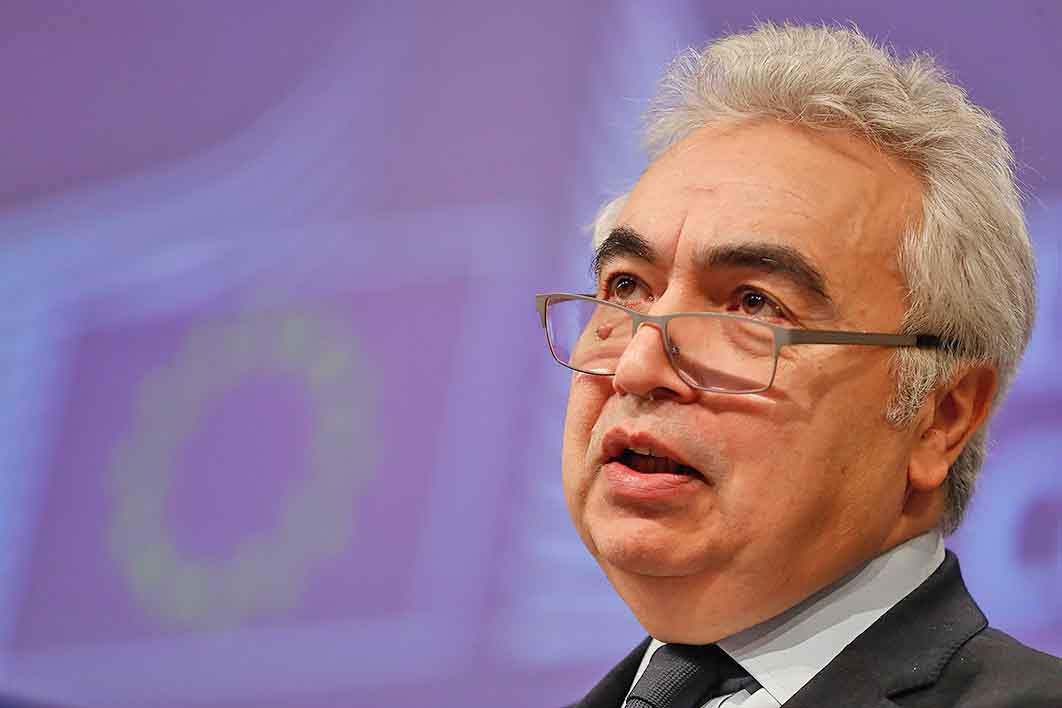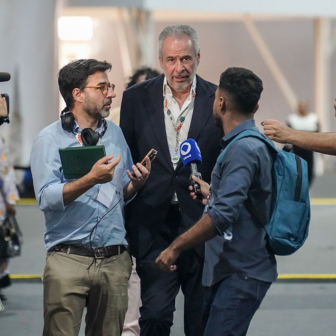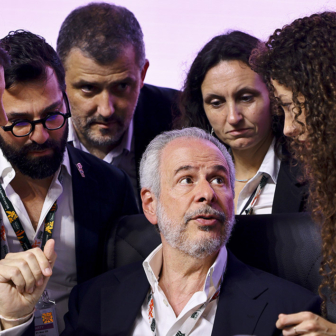When governments met in Paris at the end of 2015 to craft a framework for reducing greenhouse gas emissions, they included the ambiguous goal of holding global warming to 1.5°C above pre-industrial levels. Some observers assumed this was a benchmark governments intended to meet. No, said others, they weren’t setting an official target, they were just saying it’d be nice if we could keep to that figure.
After this year’s startling rises in global temperatures and climate-related disasters, we may need to move the goalposts. Scientists at the European Union’s Copernicus Centre estimate that Earth’s average surface temperature was already 1.23°C higher by August 2023 than in pre-industrial times. At that rate, the temperature anomaly will top 1.5°C by 2035.
By chance, 2035 is also the next milestone year for which all countries must put forward new targets under the Paris agreement. And last week the International Energy Agency, the OECD’s energy counterpart, warned that current policy settings mean the world is on course for temperatures to be 2.4°C warmer by 2100 than in days of old.
The IEA is funded by Western governments, including Australia. It advocates a rapid “clean energy transition” to net zero emissions — but it knows that success ultimately depends on support from key developing countries, especially China and India. So its pitch is diplomatic; where activists see climate disaster ahead, the IEA sees a glass half full. Before the 2015 conference in Paris, the agency notes, its equivalent modelling found global warming would lift average temperatures in 2100 by 3.5 degrees.
The IEA’s latest report, Net Zero Roadmap: A Global Pathway to Keep the 1.5°C Goal in Reach, updates its 2021 Roadmap ahead of the coming COP28 ministerial meeting on climate in Dubai. Essentially, it’s a blueprint for ministers and their governments: if you’re serious about reducing greenhouse gas emissions to net zero by 2050, something like this is what you should be aiming for.
Its advice is pitched at countries in general: it offers no specific recommendations to any of them. But on one key question in the Australian debate — is it right to expand coal and gas fields for exports? — the IEA’s stance puts it clearly in line with the Greens and against the two major parties.
“There is no need for investment in new oil and gas projects,” the IEA’s executive director, Turkish energy economist Fatih Birol, declared at the report’s launch in Paris. A few countries would still use oil and gas in a world of net zero emissions, or NZE, but the IEA estimates global demand for fossil fuels will peak in this decade and then fall precipitously. That makes new investments a risky proposition.
If the IEA’s roadmap to NZE is followed, which is unlikely, global oil consumption will be just 7 per cent of today’s levels by 2050, gas consumption just 5 per cent, and consumption of coal just 2 per cent. But, as the report keeps pointing out, we’re not there yet.
Laura Cozzi, the IEA’s director of sustainability, technology and outlooks, pointed out that global emissions in the energy sector hit a new record level last year despite significant falls from 2019 levels in advanced economies. Certain unnamed countries, she noted, are still building new coal-fired power stations, expanding fossil fuel projects and heavily subsidising fossil fuels. She summed up the world’s prospects of keeping global warming to 1.5°C: “Not. Good.”
And yet the IEA’s key message is that it’s still possible. “While the global pathway to net zero by 2050 has narrowed, it is still achievable,” Dr Birol concluded. “It is too soon to give up on 1.5°C.”
Why? Partly, perhaps, because if the IEA gave up on that goal then governments would be free to do so as well. But partly, too, because the transition is going very well in some respects — and if governments and business bring the same focus to where they’re lagging, they could dramatically change the global trajectory.
First, the good news. In some key areas, the world is moving fast enough to meet the milestones set out in the 2021 roadmap. In two of them, it’s on track to do better than that. All this is bending the curve of our trajectory from fossil fuels to renewables, but governments have to maintain momentum by progressively tightening that curve.
For example: the decline in future global warming under current policies from the 3.5°C the IEA estimated in 2015 is not enough, but it is a dramatic start. It reflects significant shifts in government policies, business costs, technological development and investment decisions.
Back in 2015, the report implies, the IEA was expecting the global energy sector to be emitting about 42.5 gigatonnes (Gt, or billion tonnes) of greenhouse gases by 2030. Eight years later, it now expects the same sector to be emitting 35 Gt, a drop of 7.5 Gt, or 18 per cent, in just eight years.
Okay, numerous factors are involved in that. They include reduced economic growth as a result of Covid, technological breakthroughs in many areas, and the IEA’s past underestimation of the scale of the shift to solar. That aside, though, government, business and people have changed their priorities in some areas to abandon unsustainable ways of doing things in favour of sustainable ones.
The IEA report estimates that almost half of that 7.5 Gt difference in its new and old forecasts of the energy sector’s 2030 emissions has come from breakthroughs in just one sector: solar energy. It kept expecting solar energy’s dazzling growth to fizzle out, but got that very wrong; instead, solar’s price kept falling, demand kept rising, and month by month it has been replacing coal and gas power. The report estimates that by 2030, under existing policies, solar and wind will each generate roughly 15 per cent of the world’s electricity.
In Australia, solar already has that share of the market, wind slightly less. Our problem lies in creating the storage and transmission capacity to operate a system based on intermittent power sources. Australia is the world’s number one in per capita use of solar, but its transmission network was built for another age, and it has a charming tradition of allowing its farmers to be the world’s number one NIMBYs.
The IEA’s report unfortunately sheds no light on how we should fix these problems. But it does tell us that solar energy use is growing even faster than its 2021 report hoped for, and wind almost as fast, and their combined growth has provided 5 Gt of the 7.5 Gt saving in 2030 emissions.
Another 1 Gt comes from another renewable (or potentially renewable) source: electric vehicles. Here too, like everyone else, the IEA was caught by surprise. In 2015 it expected that electric cars would make up 2.5 per cent of the global car market by 2030. Now it predicts they will make up almost 40 per cent — or more if policies and research moves to bring them on faster, especially for trucks and commercial vehicles.
Some of their growth is due to policy shifts. Governments in the European Union and the United States stared down the car manufacturers, imposing tough emissions standards that forced them to switch strategy to focus on making electric cars. India and some other developing countries rolled out financial incentives and charging stations to replace the masses of tuk-tuks (two-/three-wheelers) on their roads. And, like the boom in solar, the boom in electric cars was made possible by China’s goal of creating new global industries it can dominate (though that has its own problems).
On some issues, some governments are getting serious about trying to stop global warming. And if they’re not, business is doing it for them. The IEA reports that in the last two years business investment in low-emissions energy grew by 40 per cent to US$1.8 trillion, more than Australia’s entire annual output. That’s just as well, because from 2022 to 2030, on the IEA’s roadmap, it will need to grow to US$4.5 trillion.
“We now estimate that global manufacturing capacities for solar PV and electric vehicle batteries would be sufficient to meet projected demand in 2030 in the updated NZE Scenario, if announced projects proceed,” the report concludes. “This progress reflects cost reductions for key clean energy technologies — solar PV [photovoltaic], wind, heat pumps and batteries — which fell by close to 80 per cent… between 2010 and 2022.”
The glass is half full. Unfortunately, it is also half empty.
The IEA’s roadmap to NZE has not changed much since 2021, but its presentation has. Reading it, you’re struck by the repeated entreaties for “fair and effective international cooperation” to help developing countries other than China to “unlock clean energy investment” so their economic growth will not require emissions growth.
You’re also struck by statistics showing that different countries are on very different paths. From 2019 to 2022, the IEA estimates, energy sectors in the European Union and the United States cut their greenhouse gas emissions by 4.5 per cent. But despite its world-leading roles in developing solar, wind and electric cars, China increased its emissions by 7.5 per cent, while emissions in other developing economies rose by 4.5 per cent.
You might think that’s because Westerners pump out far more emissions than China. Not so. The IEA report doesn’t analyse the issue, but its statistics tell us that the combined emissions from energy sectors in the European Union and the United States are 7.5 Gt a year. That’s just 20 per cent of the world total.
If the advanced economies meet their upgraded targets under the Paris agreement — a big if, as British politics shows — their emissions in 2030 would be 5.5 tonnes of greenhouse gases per head, whereas China emits 7.5 tonnes per head and growing. (Australia is an outlier, its total emissions being roughly 20 tonnes of greenhouse gases per head if you exclude the big discount it claims for stopping land clearing.) “The policies currently in place are inadequate to meet [countries’] stated national commitments, let alone longer-term net zero emissions pledges,” the IEA concludes.
Europe has led the way in reducing emissions, but the cynicism with which British prime minister Rishi Sunak has now reversed course to try to win re-election suggests that public support for that role is fragile. The Biden administration has made the United States another global leader, but if the Republicans win back the White House next year, then that too will go into reverse.
Xi Jinping doesn’t have to worry about re-election, and global net zero emissions would be unthinkable without China’s leadership in developing low-cost solar power technology and componentry for wind turbines, electric cars and heat pumps. But China under Xi has also built most of the world’s new coal-fired power stations; it now has 71 per cent of all coal-fired plants in the global pipeline.
However urgent the need for action, there is nothing inevitable about the world achieving net zero emissions within a generation. The European Union and rich countries on this side of the Pacific have written their net zero pledges into law, but few developing countries have followed. And, of course, the United States can no longer make bipartisan commitments.
But as I pointed out in reporting the IEA’s 2021 roadmap, the developing countries are the ones that matter most. They will be generating most of the world’s economic growth from here to 2050, and they will decide how to power it. Not only China and India, Indonesia and Brazil, but Africa too. In general, they’ve been cautious about what they commit to, and with good reason. They claim the West has kept promising financial help to develop clean energy, but has sometimes failed to deliver.
The IEA report frequently alludes to this, emphasising the developing world’s needs for financial and technological support. It suggests that the West bring forward its net zero target date from 2050 to 2045, China advance its deadline from 2060 to 2050, and other developing countries (most of whom are relatively minor emitters) take their time. The cause needs them on board.
The IEA’s milestones are challenging. In 2022, the world generated 61 per cent of its electricity by burning coal, gas and oil. (In Australia it was 68 per cent.) The IEA wants that dependence swept away, cutting fossil fuels’ share to 29 per cent by 2030 and just 9 per cent by 2035. Australia has set itself an even more ambitious target to cut fossil fuels to just 18 per cent of electricity generation by 2030, but there’s a growing consensus that we won’t make it.
The IEA wants 70 per cent of new vehicles sold globally by 2030 to be electric, up from 13 per cent in 2022, and then 98 per cent by 2035. By 2030 it proposes that space heating and cooling systems in all new buildings use energy-efficient heat pumps (or split systems), a huge change from less than 1 per cent in 2022.
It sounds dramatic, but the IEA argues that electric cars and heat pumps will save the customer money in the long term — just as solar and wind energy are cheaper than burning coal and gas. That’s why these four cheap, mature technologies are its priorities for action now.
The report skates over the problems that Australia and other countries are experiencing as solar and wind energy make coal-fired power uneconomic in daylight hours, yet it remains a necessity at night. Its recent report on Australia acknowledged the problem, but offered no solution except a sort of “try harder.”
But much in the report is relevant to Australia. It implicitly rejects Labor’s policy of phasing out fossil fuels at home while expanding exports for others to burn. If our goal is to stop global warming, you can’t do it by transferring emissions from power stations here to power stations in Asia. You can argue the detail of how the transition to renewables should be managed, but the IEA insists that fossil fuels must be phased out throughout the world. As Dr Birol explains, “What matters is emissions, regardless of which country produces them.”
Reducing the destructive methane emissions caused by mining fossil fuels is another of the IEA’s key priorities. Often, it says, it would be far cheaper for miners to capture the escaping gas and use it. Australia was a late signatory to the global pledge to try to reduce methane emissions by 30 per cent by 2030. They have become the fastest-growing source of Australia’s greenhouse gas emissions.
The climate debate here focuses on renewables vs fossil fuels, but the IEA’s focus is on “low-emissions sources of electricity.” That includes nuclear power and carbon capture, usage and storage. Both are outcasts in Australian debates — the Howard government even banned nuclear power stations — but remain in the IEA’s toolkit, albeit for use only in rare cases.
It’s safe to assume that the Coalition’s new campaign for nuclear power in Australia is primarily aimed at renewing the climate wars; nuclear would be an expensive way to provide backup power at nights and on gloomy days. Even the IEA, as strong an advocate as any, sees nuclear providing just 2.7 per cent of the new “low-emissions” capacity it advocates for the world.
Rather, its emphasis is on the potential savings the world could make by focusing on energy efficiency: in homes, offices, shops and factories, cars, planes, ships, everywhere. As an example, redesigning new fridges and air conditioners could cut their electricity consumption almost in half by 2035.
Nothing would score better in human welfare than a global campaign to give every household in the developing world access to clean cooking technology to replace their deadly old indoor wood fires. If this could be done by 2030, the IEA estimates, it would remove 1.5 Gt a year of greenhouse gas emissions and save 3.6 million premature deaths. And that would cost just 1 per cent of the world’s annual energy investment.
But these changes require political or business decisions. The IEA offers only nonpartisan expertise — something that governments here and elsewhere don’t value as much as they should. The agency has to keep its mouth zipped, especially on how to solve the problems it exposes. Take energy efficiency. The obvious way to increase efficiency is a carbon price: make it more expensive to waste energy, and people will find ways to cut its use. But to many on the right, a new tax is taboo. So the IEA has to tiptoe around by suggesting second-best solutions.
The Albanese government is in danger of overpromising on targets while underdelivering on policies to achieve them. Its carbon price is limited to 200-odd companies, it is walking both sides of the street on fossil fuels, and most of the reviews it has launched have yet to produce outcomes. This is what happens when you allow the political staff to take charge of policy. •




